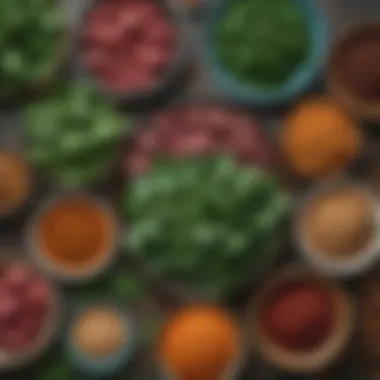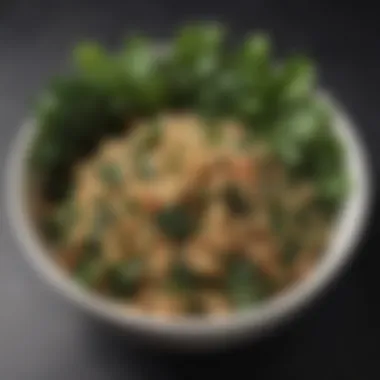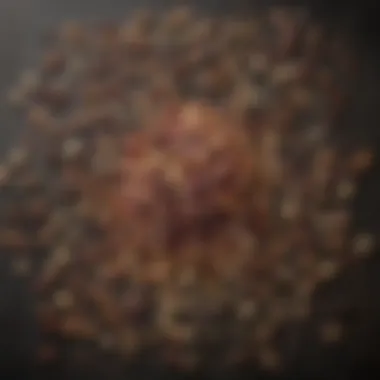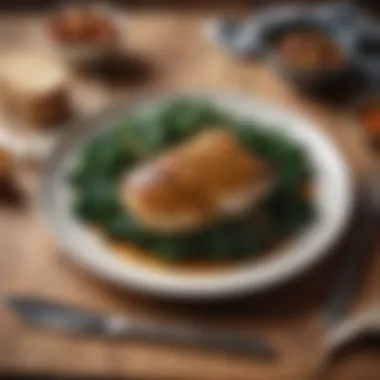Exploring Foods High in Iron: A Comprehensive Guide


Intro
Iron plays a critical role in human health, yet many people do not consume sufficient amounts through their diets. It is essential for the production of hemoglobin, which carries oxygen in the blood, and is involved in numerous metabolic processes. This article aims to provide a thorough understanding of foods high in iron, distinguishing between heme and non-heme sources.
Heme iron is found in animal products such as meat and fish, while non-heme iron is predominantly in plant-based sources. The bioavailability of these iron types varies, which means that some sources are more easily absorbed by the body than others.
Understanding which foods are rich in iron can help individuals tailor their dietary choices not only to meet their iron needs but also to support overall health. In the sections below, we will explore the diverse range of iron-rich foods, examine their health benefits, and discuss strategies to enhance iron absorption.
"Consuming a variety of iron-rich foods is key to preventing deficiencies and promoting optimal health."
Recipe Overview
Iron-Rich Stir-Fry
This colorful stir-fry is an excellent way to incorporate iron-rich ingredients into your meals. Packed with vegetables, lean protein, and flavorful spices, it is both nutritious and satisfying.
Description of the Dish
The iron-rich stir-fry combines fresh spinach, bell peppers, and lean chicken or tofu, ensuring a good balance of heme and non-heme iron. This dish not only provides substantial amounts of iron but is also quick to prepare, making it ideal for busy weeknights.
Ingredients
- 2 cups of fresh spinach
- 1 cup of chopped bell peppers
- 1 cup of diced chicken or tofu
- 2 tablespoons of olive oil
- 2 cloves of garlic, minced
- 1 tablespoon of soy sauce
- Salt and pepper to taste
Special Notes on Ingredients
- For a vegetarian option, use tofu instead of chicken.
- Bell peppers can be substituted with any colorful vegetables, such as broccoli or carrots, based on preference.
- Consider adding a squeeze of lemon juice at the end to enhance iron absorption.
This guide aims to empower readers to make informed choices about iron-rich foods, ultimately leading to a healthier lifestyle.
Foreword to Iron's Importance
Iron is a vital mineral that plays a significant role in human health. Understanding its importance in our diet is crucial for achieving well-being. This section provides insights into the significance of iron, its sources, and its benefits in maintaining various bodily functions.
Understanding Iron
Iron is an essential nutrient that the body requires in order to function optimally. There are two types of iron in food: heme and non-heme. Heme iron is typically found in animal products and is more easily absorbed by the body. Non-heme iron is found in plant-based sources and is more abundant in our diets. The difference in absorption rates is important when considering how to fulfill daily iron requirements.
Iron is a component of hemoglobin, which carries oxygen in the blood. Without sufficient iron intake, the body can struggle to produce enough healthy red blood cells, leading to fatigue and reduced immune function. Therefore, understanding iron can help individuals make informed dietary choices.
The Role of Iron in the Human Body
The role of iron extends beyond just oxygen transport. It is involved in numerous cellular processes, including the metabolism of energy. Iron contributes to the creation of collagen, supports the immune system, and is necessary for the synthesis of certain hormones.
An adequate iron level is crucial during various life stages. For instance, pregnant women require higher iron intake to support fetal development. Additionally, growing children and adolescents need iron for growth spurts and cognitive development.
"Iron deficiency can lead to significant health issues, including anemia, fatigue, and compromised immune response."
Thus, understanding iron and its pivotal role in overall health is essential for everyone. This knowledge can guide better dietary choices and promote healthier lifestyles.
Types of Iron


Understanding the two distinct forms of iron available in food sources is crucial when discussing iron content. These two types are heme iron and non-heme iron. Each type plays different roles in nutrition and absorption, thus affecting overall dietary choices. Knowing the differences helps in planning meals that meet individual iron needs while considering the sources for optimal iron intake.
Heme Iron Sources
Heme iron is primarily found in animal-based foods and is absorbed more efficiently by the body compared to non-heme iron. Sources of heme iron include red meat, poultry, and certain seafood. The iron from these sources is about 15 to 35% absorbable, a significant advantage for individuals wanting to boost their iron levels. Common sources include:
- Beef, particularly cuts like liver, which are exceptionally rich in iron.
- Chicken and turkey are also good choices, especially dark meat parts.
- Fish such as salmon, tuna, and sardines provide healthy amounts of heme iron.
When including these foods in your diet, it is beneficial to consider how cooking methods affect iron content. Grilling, broiling, or roasting can help retain more nutrients compared to frying or boiling.
Non-Heme Iron Sources
Non-heme iron exists in plant-based foods and dairy products. This form of iron is not absorbed as well as heme iron, only around 2 to 20% efficiency depending on various factors. However, non-heme iron is abundant in a wide variety of foods, making it easily accessible for those following vegetarian or vegan diets. Key sources include:
- Legumes and pulses like lentils, chickpeas, and kidney beans.
- Leafy greens such as spinach and kale, recognized for their high nutrient profile.
- Nuts like almonds and cashews, which provide both iron and healthy fats.
- Whole grains including quinoa and fortified cereals, important staples in many diets.
It is essential to combine non-heme iron sources with foods high in vitamin C, such as citrus fruits or bell peppers, as this can significantly enhance absorption.
Looking at both heme and non-heme iron sources allows individuals to form a balanced diet tailored to their preferences. Adjusting your food choices to include a variety of these sources can greatly enhance iron levels in the body and contribute to overall health.
Animal Sources of Iron
Animal sources of iron are significant for individuals seeking to boost their iron intake effectively. Heme iron, which is present in these foods, is generally better absorbed than non-heme iron found in plant-based foods. This section will detail various sources of heme iron, focusing on red meat, poultry, and seafood. Each of these food groups offers unique nutritional benefits and considerations, making them essential elements of a balanced diet.
Red Meat
Red meat is a prime source of heme iron, providing a substantial boost to iron levels in the body. Common examples include beef, lamb, and pork. The iron in red meat is readily accessible, making it a convenient option for alleviating iron deficiency. Besides iron, red meat contains several important nutrients, such as protein, zinc, and B vitamins, particularly B12.
It is worth noting the potential health considerations related to consuming red meat. High intake has been associated with certain health risks, including cardiovascular disease. Therefore, it is advisable to consume red meat in moderation, balancing it with other protein sources.
Key Points about Red Meat:
- Excellent source of heme iron.
- Provides essential nutrients, including protein and B vitamins.
- Should be consumed in moderation to minimize health risks.
Poultry
Poultry, such as chicken and turkey, is another valuable source of iron. It generally contains lower levels of iron than red meat but still offers significant amounts of this mineral, particularly in dark meat portions. Additionally, poultry provides a lean source of protein with lower fat content.
When considering poultry, it is important to choose methods of cooking that do not significantly add unhealthy fats. Roasting or grilling are beneficial methods to preserve nutritional benefits. The versatility of poultry makes it easy to incorporate into various recipes and meals throughout the week.
Fish and Seafood
Fish and seafood are excellent sources of iron, especially certain types such as canned tuna, salmon, and shellfish. These foods are not only rich in iron but also provide omega-3 fatty acids, which have been linked to numerous health benefits.
Shellfish, in particular, can be particularly high in iron. For example, oysters are known to have significant amounts of iron along with other trace minerals. Incorporating seafood into your diet can provide a flavorful way to increase iron intake while enjoying other health advantages.
Plant Sources of Iron
Plant sources of iron are crucial for those aiming to bolster their iron intake, particularly for vegetarians and vegans. These foods provide a variety of nutrients alongside iron, fostering overall health. Unlike their animal counterparts, plant-based iron sources offer additional advantages such as fiber and phytonutrients. Nevertheless, it is essential to note that the iron in these foods is mostly non-heme iron, which is less readily absorbed by the body. Thus, understanding how to maximize the benefits of these sources is key.
Legumes and Pulses


Legumes and pulses stand out as significant plant sources of iron, with options like lentils, chickpeas, and beans boasting impressive iron content. For example, cooked lentils provide about 3.3 mg of iron per 100 grams, making them an excellent choice. Apart from iron, they are rich in protein and fiber, promoting digestive health and satiety. To enhance absorption, combining legumes with vitamin C-rich foods, such as bell peppers or tomatoes, is advisable.
Leafy Greens
Leafy greens are another vital source of iron, particularly for those who consume a plant-based diet. Spinach, kale, and Swiss chard contain modest amounts of iron, often around 2.7 mg per 100 grams for cooked spinach. These greens are also packed with vitamins, minerals, and antioxidants. However, spinach contains oxalates that can inhibit iron absorption. Sautéing spinach or pairing it with a source of vitamin C can help counteract this effect and enhance iron bioavailability.
Nuts and Seeds
Nuts and seeds present a tasty and nutritious way to incorporate iron into one’s diet. Pumpkin seeds, for example, contain approximately 8.8 mg of iron per 100 grams. Nuts such as cashews and almonds also provide iron, though in lower amounts. They are not only rich in iron but also contain healthy fats and protein. Snacking on nuts or adding seeds to meals can contribute to overall iron intake, making them a smart dietary choice.
Whole Grains
Whole grains like quinoa, brown rice, and oatmeal serve as another excellent source of iron. Quinoa, for instance, offers about 2.8 mg of iron per 100 grams. Unlike refined grains, whole grains retain their bran and germ, which contain higher quantities of nutrients, including iron. Including a variety of whole grains in everyday meals can help improve iron consumption. Cooking these grains with a splash of lemon juice or adding herbs can further enhance nutrient absorption.
Fortified Foods
Lastly, fortified foods may play a significant role in addressing iron deficiency, especially in individuals who follow strict diets. Many cereals and plant-based milk products are fortified with iron to help boost overall intake. The iron content in these products can vary, so checking nutrition labels is advisable. Incorporating these fortified options into breakfast or snacks can easily augment iron levels and help meet daily requirements.
Iron Absorption Factors
Iron absorption is a critical aspect in ensuring the body receives sufficient amounts of this essential mineral. The body's ability to absorb iron effectively may determine whether an individual develops iron deficiency or maintains adequate iron levels. Factors affecting iron absorption include dietary components, individual health conditions, and even the method of food preparation.
Enhancing Iron Absorption
Several strategies can optimize the absorption of iron from dietary sources. First, including vitamin C-rich foods in meals is highly beneficial. Foods such as oranges, strawberries, and bell peppers can significantly enhance non-heme iron absorption. This is especially pertinent for those who primarily consume plant-based iron sources.
Moreover, cooking methods influence iron bioavailability. For instance, using cast iron cookware can enrich foods with additional iron, particularly when preparing acidic foods like tomato sauce. On a similar note, soaking and sprouting legumes or grains can break down phytates that inhibit iron absorption.
- Eating iron-rich foods with enhancers: Accompany grains and legumes with foods high in vitamin C.
- Using cast iron utensils: This adds iron to food during cooking.
- Soaking and sprouting: This can reduce inhibitors in legumes and grains to enhance bioavailability.
Consider testing various combinations to find what works best for personal dietary habits.
Inhibitors of Iron Absorption
While certain foods can enhance iron absorption, others can hinder it. Understanding these inhibitors is just as essential for maintaining adequate iron levels. Phytates, found in whole grains and legumes, can bind to iron, making it less available for absorption. Furthermore, tannins in tea and coffee can also inhibit iron absorption when consumed in proximity to meals.
Calcium, a mineral vital for bone health, competes with iron for absorption in the intestines. It is wise to consume high-calcium foods or supplements separately from iron-rich meals to avoid interference.
Here are common inhibitors to be mindful of:
- Phytates: Present in whole grains and legumes.
- Tannins: Found in tea and coffee.
- Calcium: Competes with iron; consider timing your calcium intake.
Understanding these inhibitors can play a vital role in meal planning and dietary choices.
Dietary Recommendations
Dietary recommendations provide essential guidance on how to reach adequate iron intake through food choices. These guidelines are particularly vital for individuals with varying needs, such as pregnant women, growing children, and individuals who follow vegetarian or vegan diets. Iron is not only integral to hemoglobin formation but also supports overall health and immune function. Properly planned diets help prevent iron deficiency and maintain optimal levels of this critical nutrient.
Daily Iron Requirements
Daily iron requirements can vary depending on age, sex, and life stage. Generally, the recommended dietary allowance (RDA) for iron is:


- Men (19-50 years): 8 mg
- Women (19-50 years): 18 mg
- Pregnant women: 27 mg
- Lactating women: 9-10 mg
- Older adults (>50 years): 8 mg for both men and women
These recommendations highlight that women of childbearing age need higher intake due to menstrual blood loss. During pregnancy, the body's demand for iron increases to support fetal development. Understanding these requirements helps individuals tailor their diets to meet their specific needs effectively. It should be noted that factors such as physical activity level and overall health can further influence these guidelines.
Iron-Rich Meal Planning
Planning meals rich in iron involves carefully selecting foods from both heme and non-heme sources. Here are some practical tips for iron-rich meal planning:
- Incorporate a variety of heme sources: Red meat, poultry, and fish should be included regularly as they provide bioavailable iron.
- Include non-heme iron sources: Beans, lentils, nuts, and fortified grains should also form part of the diet. These foods can be combined in meals to enhance overall iron intake.
- Pair with Vitamin C: Consuming foods high in vitamin C, such as citrus fruits or bell peppers, alongside iron-rich meals can significantly enhance non-heme iron absorption.
- Use cooking methods that preserve iron: Cooking in cast iron pans may increase the iron content of food. This method can be particularly beneficial when preparing acidic foods like tomato sauce.
- Plan balanced meals: Focus on combining various food groups. A meal might include grilled chicken with a side of spinach salad and a citrus dressing. This combination promotes not only iron intake but also overall nutrition.
"Understanding how to design meals with adequate iron can lead to better health outcomes and prevent deficiencies."
By following these guidelines, individuals can ensure their nutritional needs for iron are met while enjoying a diverse and flavorful diet.
Impact of Iron Deficiency
Iron deficiency is a pressing global health issue that can lead to serious physical consequences. When the body lacks sufficient iron, it struggles to produce hemoglobin, the protein in red blood cells that carries oxygen throughout the body. This deficiency can result in anemia, leading to a decrease in the quality of life and overall well-being. It is thus essential to grasp the effects of iron deficiency, as the impact extends beyond merely feeling fatigued.
Understanding the incidence and ramifications of iron deficiency can drive awareness and encourage proactive dietary adjustments. The consequences can vary by age, sex, and lifestyle, making it crucial to identify those at greater risk. Many individuals do not recognize the symptoms until they are significantly impaired.
"The symptoms of iron deficiency can be subtle at first, but they may lead to serious health problems over time."
Addressing this deficiency through proper nutrition offers substantial benefits. Ensuring an adequate intake of iron-rich foods is a simple yet effective measure. Awareness can also help one to implement these dietary changes to improve overall health. For instance, iron supplementation might benefit certain populations, but dietary changes should be considered first.
Symptoms of Iron Deficiency
The symptoms of iron deficiency can be both diverse and generalized, making recognition important. Some common signs include:
- Fatigue: One of the most common symptoms, often reported as feeling exhausted despite adequate rest.
- Pale Skin: A noticeable loss of color in the skin, often seen in the face, nail beds, and inside the lower lids of the eyes.
- Shortness of Breath: An increased difficulty in breathing, particularly during physical exertion, due to insufficient oxygen in the body.
- Heart Palpitations: A sensation of rapid or irregular heartbeat, as the heart works harder to compensate for low hemoglobin levels.
- Dizziness or Lightheadedness: Feeling faint or weak, especially when standing, may indicate low blood iron levels.
These symptoms should prompt further investigation. Although they may seem mild, their combined effect can severely hinder daily activities and overall health.
Risk Groups for Iron Deficiency
Certain populations are more susceptible to iron deficiency. Recognizing these risk groups is vital to implementing preventive measures effectively.
- Pregnant Women: Increased iron needs to support fetal development and blood volume levels.
- Infants and Young Children: Rapid growth and higher iron requirements during early development make them particularly vulnerable.
- Vegetarians and Vegans: Plant-based diets can sometimes lack sufficient iron, especially the heme form, that is more readily absorbed by the body.
- Individuals with Chronic Diseases: Conditions such as kidney disease or cancer can impair iron absorption and utilization.
- Athletes: Especially endurance athletes, may face heightened iron needs due to increased oxygen demands and potential losses through sweat.
Awareness in these groups encourages proactive dietary choices to avert potential health issues. Regular blood tests can also aid in monitoring iron levels, ensuring appropriate interventions when necessary.
Closure
In wrapping up this comprehensive exploration of iron-rich foods, it is imperative to reiterate how crucial iron is to overall health. Iron is not merely a nutrient but a fundamental element involved in numerous biological processes, including oxygen transport and energy production. Its importance cannot be overstated, especially in a world where many individuals are unaware of their iron needs and food sources.
Summary of Key Points
Throughout this guide, we have discussed various aspects related to iron:
- Types of Iron: Understanding the two forms of dietary iron—heme and non-heme—provides clear insight into food sources. Heme iron, found in animal products, is absorbed more efficiently than non-heme iron, which comes from plant-based sources.
- Iron Sources: Various food items were highlighted as excellent sources of iron, including red meat, poultry, seafood, legumes, leafy greens, and fortified foods. Emphasizing a diverse diet is essential for ensuring adequate iron intake.
- Absorption Factors: The absorption of iron is influenced by several factors, including the presence of vitamin C, which enhances absorption, and the inhibitors such as phytates found in grains and polyphenols in tea and coffee. Understanding these factors allows for better meal planning.
- Deficiency Concerns: We outlined the symptoms of iron deficiency and identified at-risk groups, including pregnant women, vegetarians, and individuals with certain health conditions. Awareness of these factors can lead to proactive dietary choices.
Final Thoughts on Iron in Diet
In light of our findings, maintaining adequate iron levels should be a priority for everyone. Not only does a well-balanced intake of iron support physical health, but it also enhances cognitive function and overall vitality. Incorporating a varied diet, which includes both heme and non-heme sources of iron, is essential.
"Iron plays an indispensable role in human health, affecting both physical and mental well-being."
So, when planning meals, consider reviewing this guide and approaching your diet with intentionality. Doing so ultimately benefits not just individual health but contributes to a more informed society that values nutritional adequacy.







